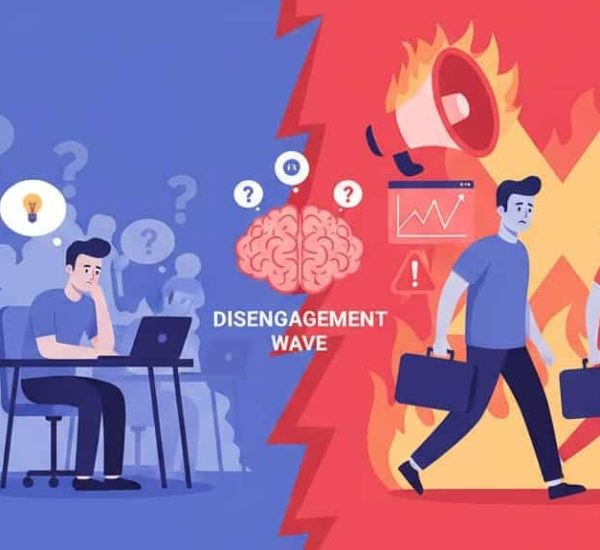High-pressure work environments are often seen as the cost of doing business—especially in fast-paced industries like tech, finance, and professional services. But when stress becomes the norm, it leads to burnout, disengagement, and high turnover, making it harder for teams to perform at their best.
For HR leaders and People & Culture teams, the challenge isn’t just acknowledging workplace stress—it’s building a culture that actively helps employees manage it. Leadership may hesitate to invest in HR wellness initiatives, fearing they’ll disrupt productivity, but research shows that a mindfulness-driven approach can actually enhance focus, resilience, and overall performance.
This guide explores how HR teams can integrate mindfulness culture into their organizations, using practical stress management strategies that don’t just check a box but create lasting change. From proven wellness programs to real-world case studies, we’ll break down the steps to building a workplace where employees feel supported—mentally, emotionally, and professionally.
Why Mindfulness Matters in High-Stress Work Environments
In high-pressure industries, stress isn’t just an occasional challenge—it’s a constant reality. Tight deadlines, heavy workloads, and the expectation to always be “on” can lead to burnout, decreased productivity, and even higher turnover rates. While some companies try to address stress with one-off wellness perks like meditation apps or occasional mental health days, these surface-level solutions rarely create lasting change.
That’s where mindfulness culture comes in. Unlike temporary stress relief tactics, a true mindfulness-driven workplace embeds stress management into daily operations, helping employees build resilience instead of just reacting to stress. When employees are encouraged to be more present, self-aware, and intentional in their work, they become more engaged, creative, and better equipped to handle pressure.
For HR leaders, the goal isn’t to eliminate stress entirely—that’s impossible. Instead, it’s about creating an environment where employees have the tools to manage stress effectively, allowing them to stay productive without sacrificing their well-being.
The Tangible Benefits of Implementing Mindfulness in the Workplace
Integrating mindfulness practices into high-stress work environments offers measurable advantages that extend beyond individual well-being. Organizations that have adopted mindfulness programs report improvements in employee health, productivity, and overall workplace culture.
1. Enhanced Employee Well-Being and Reduced Stress
Mindfulness practices, such as meditation and deep-breathing exercises, have been shown to alleviate stress and anxiety among employees. For instance, Aetna, a leading healthcare company, introduced mindfulness programs and observed a 28% reduction in employee stress levels along with a 20% improvement in sleep quality.
2. Increased Productivity and Focus
Employees who engage in mindfulness training often experience heightened concentration and efficiency. A study highlighted that participants in a mindfulness program reported a 31% reduction in stress, a 15% increase in well-being, and enhanced leadership and teamwork skills.
3. Improved Workplace Relationships and Collaboration
Mindfulness fosters empathy and better communication among team members. Companies implementing these programs have noted improved organizational climate and teamwork, according to LinkedIn.
4. Lower Healthcare Costs
By reducing stress-related ailments, mindfulness programs can lead to significant savings in healthcare expenses. Aetna‘s mindfulness initiative resulted in an average annual healthcare cost reduction of $2,000 per employee.
5. Enhanced Employee Retention
Organizations that prioritize employee well-being through mindfulness initiatives often see higher job satisfaction and retention rates. A hospitality company implemented a wellness rewards program, including mindfulness training, and experienced increased employee satisfaction and retention.
These benefits underscore the value of integrating mindfulness into workplace cultures, particularly in high-stress industries. By doing so, organizations not only support their employees’ mental and physical health but also enhance overall performance and profitability.

Implementing Mindfulness: Practical Strategies for High-Stress Work Environments
Integrating mindfulness into the workplace requires thoughtful planning and commitment. By following these steps, companies can create a more mindful workplace that supports better stress management, enhanced focus, and improved overall well-being.
-
Assess Employee Needs
Before launching a mindfulness initiative, it is essential to understand the specific needs and preferences of your employees. Conduct surveys or hold focus groups to gather insights about their stressors, interests in wellness programs, and previous experiences with mindfulness practices.
-
Secure Leadership Support
Leadership endorsement is crucial for the success of mindfulness programs. When leaders actively participate and promote these initiatives, it fosters a culture that values well-being and encourages employee engagement.
-
Offer Accessible Training Programs
Provide various mindfulness training options to accommodate different learning preferences and schedules. This could include in-person workshops, guided meditation sessions, and app-based training modules.
-
Integrate Mindfulness into Daily Activities
Encourage employees to incorporate mindfulness into their daily routines. This can be achieved through practices like mindful breathing exercises, setting aside time for meditation, or encouraging short, mindful breaks during work hours.
-
Create Supportive Environments
Foster an environment that supports mindfulness by providing quiet spaces for meditation, promoting a culture of open communication, and encouraging regular breaks to reduce stress and prevent burnout.
-
Measure and Evaluate Impact
Regularly assess the effectiveness of mindfulness programs by collecting feedback from participants and monitoring key metrics such as employee stress levels, job satisfaction, and productivity. Use this data to refine and improve the initiatives over time.
By implementing these strategies, organizations can cultivate a culture of mindfulness that not only enhances employee well-being but also contributes to a more productive and positive workplace.
The Business Case for Mindfulness Culture—Proving ROI to Leadership
For HR leaders and People & Culture executives, implementing mindfulness initiatives isn’t just about wellness—it’s about driving measurable business outcomes. While many companies acknowledge the importance of mental well-being, securing leadership buy-in requires demonstrating how mindfulness programs directly impact performance, retention, and overall productivity.
Mindfulness and Employee Performance
Workplace stress is a major productivity killer, leading to poor focus, impulsive decision-making, and increased errors. Research from Harvard Business Review suggests that mindfulness improves cognitive flexibility, enhances working memory, and helps employees stay engaged even under pressure. Employees who practice mindfulness report higher resilience and better problem-solving skills—critical factors in high-stress environments.
The Financial Impact of Stress Reduction
Chronic stress costs businesses billions in lost productivity and healthcare expenses. According to the American Institute of Stress, workplace stress leads to an estimated $300 billion in annual costs due to absenteeism, turnover, and medical bills. A study by Deloitte found that companies investing in mental health programs see an average return of £5 for every £1 spent due to increased productivity and lower health-related costs.
Real-World Case Studies: Mindfulness Culture in Action
Leading organizations have successfully integrated mindfulness into their workplace culture, yielding tangible results:
- Google’s “Search Inside Yourself” Program: This internal mindfulness initiative improved employee focus, emotional intelligence, and leadership effectiveness, helping to drive a culture of innovation. (Inc.com)
- Aetna’s Mindfulness Training: The insurance giant introduced mindfulness programs that led to a 28% reduction in stress levels and an annual productivity gain of $3,000 per employee. (Forbes)
- General Mills’ Meditation Rooms: By incorporating mindfulness spaces and meditation sessions, General Mills saw a reported 80% increase in decision-making clarity among senior executives. (HuffPost)
How to Sell Mindfulness to Executives
To secure leadership approval, HR leaders must present mindfulness not as a “nice-to-have” but as a bottom-line investment. Here’s how to position it effectively:
- Frame it as a performance booster: Highlight studies linking mindfulness to increased focus, creativity, and leadership skills.
- Show financial savings: Present data on reduced absenteeism, turnover, and healthcare costs tied to stress reduction.
- Tie it to company goals: Align mindfulness initiatives with leadership’s existing priorities, such as improving employee engagement scores or fostering innovation.
- Start small with pilot programs: Suggest launching a mindfulness pilot in a high-stress department and measuring its impact before scaling company-wide.
Mindfulness Makeover: Transforming High-Stress Teams in 30 Days
Workplace stress isn’t just an HR concern—it’s a productivity drain, a retention risk, and a morale killer. But what if you could transform a high-stress team into a calmer, more focused, and engaged workforce in just 30 days? This step-by-step Mindfulness Makeover Challenge provides a structured, low-resistance approach to embedding mindfulness into your workplace without overwhelming employees or leadership.
Week 1: The Quick Wins (Mindfulness in 60 Seconds or Less)
The biggest barrier to mindfulness adoption? Time. Employees and leaders alike resist new initiatives that feel like extra work. That’s why the first week focuses on frictionless, high-impact habits that can be integrated into any workday.
Start meetings with a “Reset Moment”: Before diving into agendas, take 60 seconds for deep breathing or a silent pause to improve focus. (Harvard Business Review)
Encourage the “Inbox Breath Rule”: Employees take one deep breath before opening emails or Slack, reducing reactionary responses.
Use guided micro-meditations: Provide access to a mindfulness app or play a 2-minute meditation before high-stress calls. (Headspace)
Introduce “Mindful Walking”: Instead of back-to-back Zooms, schedule walking meetings (even virtual ones) to encourage movement and clarity. (Stanford Research)
🎯 Goal: Employees experience immediate benefits without disrupting their workflow, lowering resistance to mindfulness.
Week 2: The Cultural Shift (Embedding Mindfulness in Team Norms)
Once employees see the personal benefits, it’s time to normalize mindfulness as part of company culture.
Launch “No-Meeting Mornings”: Designate one morning a week where employees can focus on deep work without interruptions.
Create Mindfulness Slack Prompts: Set up a bot (👀 AttendanceBot plug) to send gentle reminders for stretch breaks, gratitude check-ins, or deep-breathing exercises.
Introduce a “Single-Tasking Challenge”: Encourage employees to work on one task at a time for 25 minutes without checking emails or messages.
Pilot “Mindful Listening” Training: Teach managers to pause before responding and paraphrase team members’ statements to boost emotional intelligence.
🎯 Goal: Employees begin to see mindfulness as a team-wide practice, not just an individual habit.
Week 3: Leadership Buy-In (Proving Mindfulness Works)
At this stage, you need hard data and success stories to gain executive support and secure long-term adoption.
Measure engagement: Use pulse surveys to track stress levels, focus, and productivity before and after mindfulness sessions. (Gallup)
Collect employee testimonials: Ask team members to share how mindfulness has improved their work performance or reduced stress.
Highlight industry success stories: Share case studies like Google’s “Search Inside Yourself” program or Aetna’s cost savings from mindfulness initiatives. (Forbes)
Tie mindfulness to business outcomes: Demonstrate its impact on productivity, retention, and creativity—key metrics executives care about.
🎯 Goal: Make a compelling business case for mindfulness that resonates with leadership and ensures long-term investment.
Week 4: Scaling Up (Turning Mindfulness Into a Sustainable Practice)
The final step is embedding mindfulness into the company’s long-term strategy so it doesn’t fade after the challenge ends.
Designate Mindfulness Champions: Identify employees who are naturally enthusiastic about mindfulness and empower them to lead initiatives.
Create a Mindfulness Resource Hub: Provide access to short meditations, breathing exercises, and expert talks for employees to use at their own pace.
Host Monthly “Mindfulness at Work” Sessions: Bring in experts or internal advocates to reinforce mindfulness practices.
Integrate Mindfulness Into Performance Reviews: Encourage managers to check in on employees’ stress levels and well-being as part of quarterly reviews.
🎯 Goal: Ensure mindfulness becomes a natural part of company culture rather than a short-lived trend.

The Emergency Mindfulness Kit: Instant Stress Relief for High-Stakes Moments
Even with the best HR wellness initiatives, employees will still face high-stress situations—a tight deadline, an overwhelming inbox, or a difficult conversation. That’s where an Emergency Mindfulness Kit comes in.
This kit isn’t about deep meditation or hour-long retreats. It’s a rapid-response toolkit designed to de-escalate stress in under two minutes—perfect for busy professionals.
1. The 2-Minute Box Breathing Method (For Panic Moments)
Used by Navy SEALs to stay calm under pressure, this technique slows your heart rate and stabilizes stress hormones.
💨 How to Do It:
1️Inhale deeply through your nose for 4 seconds.
2️ Hold your breath for 4 seconds.
3️ Exhale slowly through your mouth for 4 seconds.
4️ Hold again for 4 seconds, then repeat.
🎯 Why It Works: Reduces stress in under two minutes while increasing focus and mental clarity.
2. The Desk Reset (For Mental Overload)
When employees are buried in work, even 30 seconds of reset time can reboot their brains.
🧘 How to Do It:
- Close your eyes.
- Take three slow, deep breaths.
- Focus on the feeling of air filling your lungs.
- Open your eyes refreshed and refocused.
🎯 Why It Works: Harvard research shows that even micro-breaks improve decision-making and concentration (Harvard Business Review).
3. Instant Calm Playlist (For Stress-Induced Brain Fog)
Music directly impacts the nervous system, making it a powerful tool for instant relaxation.
🎵 Best Tracks for a Quick Reset:
- Nature Sounds – Proven to lower cortisol levels.
- Instrumental Lo-Fi – Enhances focus without distraction.
- Classical Music – Slows the heart rate and promotes calm.
🎯 Pro Tip: Encourage employees to curate their own “calm playlist” or provide a pre-made one in Slack.
4. AI-Powered Mindfulness Nudges (For On-the-Go Stress Relief)
Employees often forget to take mindful breaks—so let technology do the work.
🤖 Tools That Help:
- Slack bots that send gentle breathing reminders.
- AI-powered wellness apps that suggest mini mindfulness exercises.
- Wearable tech alerts to signal when stress levels rise.
🎯 Why It Works: Automates stress management, making mindfulness a natural part of the workday.
Final Word
Building a culture of mindfulness in high-stress environments isn’t just about reducing tension—it’s about empowering employees to stay focused, resilient, and engaged. By integrating micro-mindfulness practices, leveraging AI-powered nudges, and providing an Emergency Mindfulness Kit, HR leaders can create a workplace where stress is managed, not overwhelming.
Small shifts in culture lead to big changes in well-being and productivity—and in today’s fast-paced world, that’s an advantage no company can afford to ignore.



